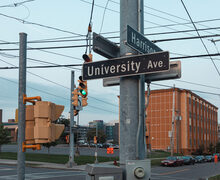Halloween traditions, costumes date back for centuries
Connor Bahng | Staff Photographer
Masks have been a Halloween staple for centuries, an easy and versatile way to celebrate the holiday.
Everyone knows Halloween for its costumes. But it is much less known why people dress up on the last day of October. The reasoning behind why people dress as a vampire or cat year after year dates back centuries.
Though the actual origins of Halloween are disputed, many historians believe the Halloween traditions we celebrate today are modern manifestations of different Celtic, Pagan and Catholic practices that date back to 800 B.C. According to history.com, it is widely believed the modern Halloween holiday is based on Samhain, also known as All Hallows’ Eve, a Celtic holiday where the barriers between real world and the supernatural world were weakened for one night.
Back then, people would don masks and costumes in hopes of impersonating spirits to protect themselves. Others would adopt a supernatural factor to their costumes, hoping to absorb the power of the creatures they were dressed as.
The origins of dressing up and going door-to-door trace back to the 16th century in Ireland, Scotland and Wales, according to The Telegraph. This was known as “mumming” or “souling;” people would receive treats in exchange for dressing up as angels, demons and saints.
During the Renaissance period in Italy, upper-class citizens would put on masquerade masks in an attempt to remain anonymous at these macabre celebrations, which at the time were seen as immoral. In contrast to the grisly masks worn by the Celtics, the ones donned at these parties were lavish and covered in jewels to match the extravagant gowns they wore.
The popularity of gothic novels meant as increase in popularity of dressing as a bat or a ghost. People were especially interested in other country’s cultures during this era, hence the popularity of Egyptian goddess and mythological costumes.
But Halloween didn’t find its footing in the United States until the 1840s, when Irish immigrants brought over the celebrations of All Saints’ Day and All Souls’ Day. Historians believe that these holidays — celebrated on Nov. 1 and 2, respectively — and Samhain, which was celebrated at the end of October, slowly combined to designate Oct. 3t as the official day of what came to be known as Halloween.
Though these traditions were brought to the U.S. in the mid-1800s, the manufacturing of costumes did not begin until the early 1900s and popularized in the 1930s.
This time period coincides with the creation of the first scary movies and thus, spooky characters. Bela Lugosi’s portrayal of the title role in “Count Dracula” in the 1931 horror film served as the country’s inspiration for vampire costumes on Halloween.
It was also around this time that women’s magazines began running articles on how to make costumes at home, until the mid-twentieth century when Halloween became a commercialized business.
The rise of pop culture TV shows in the 1950s meant big business for Halloween costume manufacturers. Companies began trademarking characters, such as Mickey Mouse and Popeye, and reaped the benefits. It is now estimated that Americans will spend over $8 billion on Halloween this year with over $3 billion of that being on costumes alone, according to a poll from the National Retail Federation. The average person will dish out around $80 a piece to dress up.

Connor Bahng | Staff Photographer
The commercialization of Halloween costumes meant that they were no longer exclusively scary. People started to opt for dressing as princesses, superheroes and politicians rather than witches, ghouls and vampires.
Halloween became a more racy holiday in the 1970s, when LGBT communities and second-wave feminists adopted the day as a means of wearing revealing outfits to celebrate their sexuality. Along with this, costume businesses saw the trend of a more liberal America and capitalized on the demand for sexy costumes, which see a steady increase in popularity year to year.
One of the most popular costumes you may see this year is the duo of an angel and a devil. This pairing date back to celebrations of All Saints’ Day, when the poorer classes would dress as either an angel or a devil on the day, while the other citizens dressed as the patron saints in a religious procession.
Though Halloween costumes are still continuing to evolve, throwback costumes, like the 1920s flapper, the 1950s greaser and the 1960s hippie have remained consistently popular every year.
According to a survey from the National Retail Federation, this Halloween will be the first year in over a decade that more children will dress up as superheroes instead of princesses. The dethroning of the princess costume is just another phase of the costume evolution that mimics American culture.
No matter which costume you decide on this year, be it a devil, princess, vampire or any of the millions of costume options to choose from, know that you are pulling from a rich past of costume history.
Published on October 24, 2016 at 9:20 pm





